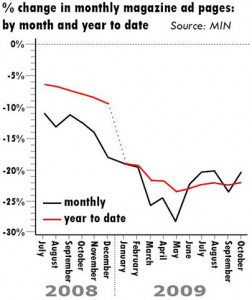 The newspaper industry's malaise has spread to the magazine business. Ad pages were off 20.1% in the most recent month, according to Media Industry Newsletter (Min), and those figures are down from an already depressed October last year. Of the 155 titles tracked by Min, 143 are down for the year. The carnage is worst in luxury titles like Architectural Digest (down 49.4%), Veranda (down 47.4%), W (down 45.5%), Town & Country (down 45.2%), Conde Nast Traveler (down 45.1%) and Gourmet (down 42.7%). Bucking the trend is Family Circle (up 13.9%) and several fitness titles.
The newspaper industry's malaise has spread to the magazine business. Ad pages were off 20.1% in the most recent month, according to Media Industry Newsletter (Min), and those figures are down from an already depressed October last year. Of the 155 titles tracked by Min, 143 are down for the year. The carnage is worst in luxury titles like Architectural Digest (down 49.4%), Veranda (down 47.4%), W (down 45.5%), Town & Country (down 45.2%), Conde Nast Traveler (down 45.1%) and Gourmet (down 42.7%). Bucking the trend is Family Circle (up 13.9%) and several fitness titles.
The magazine industry's troubles can be traced to the alarming trends in newsstand sales, which are off 37% since 2001, according to MediaPost. Newsstand sales are important because they're far more profitable than subscription sales and are also a significant source of circulation promotion. However, it appears that not many people are buying magazines on newsstands any more. Check out these numbers covering total annual newsstand sales:
| Title | 2001 | 2009 | Change |
| Woman's Day | 1,610,000 | 410,147 | -74.5% |
| Redbook | 556,355 | 154,609 | -72% |
| Playboy | 522,804 | 203,245 | -71% |
| Country Living | 380,192 | 134,884 | -64.5% |
| National Enquirer | 1,648,554 | 591,269 | -64% |
| Reader's Digest | 749,099 | 270,045 | -64% |
| ESPN The Magazine | 54,346 | 25,154 | -63% |
One title that's gone against the grain over the last eight years is The Economist, which is up 82% in that time. One reason might be innovations like a new service that enables New York City residents who receive text alerts from the magazine to order single copies delivered overnight. As long as the order is placed by 9 p.m. on Thursday, the customer can have a hard copy of that week's new issue in hand in time for the Friday commute. That's before the newsstands are even stocked. The Economist says it can provide the service at no additional charge over the newsstand price because it doesn't have to pay distribution middlemen.
Not that magazines' troubles are any solace to beleaguered newspaper publishers. Fitch Ratings says the decline in newspaper ad revenues will continue for at least another year, due to continued weakness in the print advertising market. The forecast is especially dour because it comes off terrible 2008 numbers and because most media markets are expected to enjoy a modest upturn in 2010 off of dismal results this year. PriceWaterhouseCoopers earlier forecast incremental newspaper advertising declines of 4.5% a year through 2013, noting that circulation revenue is falling in line with readership. Meanwhile, publishers are relying more and more upon circulation revenue to boost the bottom line. MediaPost documents several recent price increases by daily publishers and notes that circulation now makes up 39% of The New York Times revenue, compared to 27% five years ago.
Coupon Clipping
We somehow missed writing about this two months ago, when the survey was released, but the Newspaper Association of America just spent a lot of money on research that demonstrates that consumers rely upon newspaper advertising as an essential shopping tool. The survey of more than 3,000 consumers found that 59% cited newspapers as the "medium they use to help plan shopping or make purchase decisions," while 82% "took action as a result of newspaper advertising." Other media were way behind.
When you think about it, these results aren't surprising. Retail purchases are local, and newspapers still do the best job of delivering local advertising. It's also less convenient for a consumer to print and clip a coupon from the Internet than it is to cut it out of the newspaper. Finally, local display advertising has a better chance of catching the attention of passersby than an online banner ad, which many people block anyway. One thing the research makes clear is the importance of coupons: 90% of respondents said the presence of a coupon made it more likely they would read or look at an ad, making it the single most important influencing factor in stimulating an action. The NAA released the research as a series of short reports, all of which can be downloaded here.
http://www.newspaperdeathwatch.com/magazines-the-other-media-implosion.html








No comments:
Post a Comment